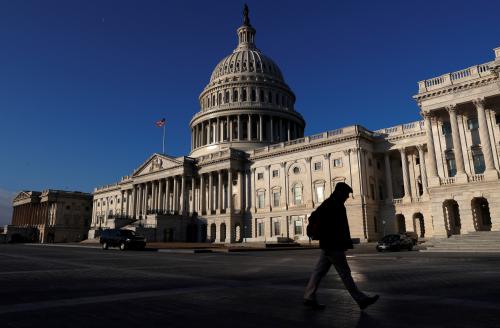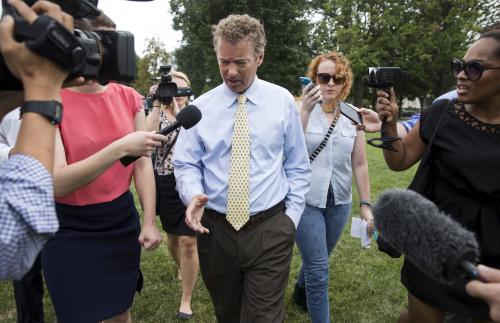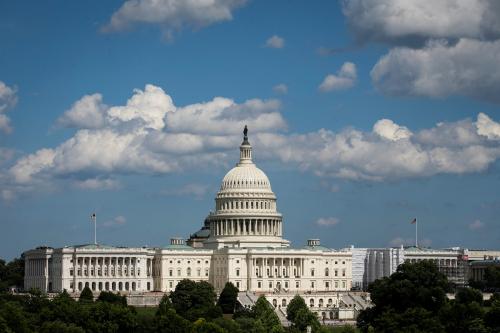 Congress ended 2018 with high budget drama. When the House and Senate convene for the 116th Congress in January, Democrats will control the former and Republicans the latter in what many have argued will be a recipe for legislative gridlock. In addition to cleaning up unfinished work from 2018, Congress will have to tackle—despite divided government—several must-pass budgetary items in 2019. Here are five things to watch for in the budget battles to come.
Congress ended 2018 with high budget drama. When the House and Senate convene for the 116th Congress in January, Democrats will control the former and Republicans the latter in what many have argued will be a recipe for legislative gridlock. In addition to cleaning up unfinished work from 2018, Congress will have to tackle—despite divided government—several must-pass budgetary items in 2019. Here are five things to watch for in the budget battles to come.
- A budget blueprint is unlikely to make it through Congress
Congress’s first step in the annual budget process is supposed to be the adoption of the congressional budget resolution, but given divided party control of Congress, that’s unlikely to happen this year. No member of a chamber’s minority party has voted for the final version of the majority party’s budget resolution in either chamber since 2008. Even if the House or Senate elects to use some floor time to adopt a measure as a messaging vehicle for party priorities, then, it’s extremely unlikely that the two chambers will reach a compromise version. As a result, both the House and Senate will have to rely on alternative workarounds to establish budgetary levels that guide the resulting appropriations process.
- The return of the caps
In 2011, as part of the legislative deal to avoid a default on the federal debt, Congress implemented caps on discretionary federal spending for both the defense and non-defense sides of the ledger for the following ten years. Roughly every two years since—first in 2013, then in 2015, and then again in early 2018—the House and Senate have deemed those limits too restrictive and increased them, but only for two years each time. The current agreement relaxing the caps expires in September 2019, and if Congress does not reach another deal lifting them again, federal agencies will have to cut approximately $71 billion on the defense side and $55 billion on the non-defense side to abide by the existing caps. (If they don’t do so, automatic cuts, known as sequestration, would kick in.) The first two rounds of negotiations on the caps resulted in similarly sized increases for both components of the discretionary budget, while the most recent iteration saw a larger increase on the defense side. With Democratic leverage over the negotiations increasing with their ascension to the House majority, demands for significant non-defense increases are likely.
- New captains at the helm
Any deal on the spending caps and the appropriations work that will flow from it will be shepherded through the process by new—and historic—leadership on the House Appropriations Committee. For the first time, the panel will be led by two women: Representative Nita Lowey (D-N.Y.) will chair the committee, with Representative Kay Granger (R-Tex.) as the ranking member. They bring significant experience in both the chamber and on the panel to the job. Lowey has served in Congress since 1989—making her the 13th most senior member of the House—and on the committee since 1993. Granger, who won a contested battle to assume the top Republican spot on the panel, has been in Congress since 1997 and began her service on the committee two years later.
In the Senate, meanwhile, the appropriations panel will be helmed by the same two leaders who saw it through a relatively productive year, in part by minimizing the role of so-called poison pill amendments, in 2018: Chair Richard Shelby (R-Ala.) and Vice Chair Patrick Leahy (D-Vt.). Whether this bipartisan cooperation persists into 2019 remains to be seen. The productivity we saw in 2018 was likely aided by the desire on the part of Republicans to deliver some concrete legislative wins while controlling the House, the Senate, and the White House. The return of divided government will allow both sides to blame the other for gridlock more easily.
- It’s not just the leadership that will change
The leadership of the House Appropriations panel isn’t the only thing that will change when Democrats assume control of the chamber in January; the basic negotiating environment for the kind of large spending deals on which Congress increasingly relies will too. In the House. Democrats have generally been more comfortable with this tactic than Republicans. Since 2003, Congress has passed 18 large, omnibus spending bills. In the House, four of these (for fiscal years 2007, 2008, 2009, and 2010) were passed under unified Democratic majorities, and an average of 94 percent of majority party legislators supported the deal. The other 14 were adopted under Republican control of the House, and the average support from GOP members was notably lower—only 73 percent.
Because a faction of House Republicans has been skeptical to support these kind of large spending packages, the party’s leadership has had to negotiate with the knowledge that they might ultimately need to turn to Democrats to get them across the finish line. Certainly, the new House Democratic majority’s most ambitious spending plans will be stymied by the fact that Republicans still control the Senate. But the House Democratic caucus is likely to be a more reliable source of votes for deals negotiated by their party leaders than their Republican colleagues have been.
- The debt limit’s back, too
In February, Congress suspended the federal debt limit through March 1, 2019; preliminary analyses from the Bipartisan Policy Center suggest that the Treasury Department will be able to use its cash on hand and “extraordinary measures” to delay the deadline for subsequent action on the debt ceiling until the summer or fall of 2019. The debt limit has often been a major flash point in budget negotiations—including in 2011, when it helped precipitate the spending caps described above after a sizable faction of Republicans were unwilling to support an increase in the ceiling without corresponding spending cuts. House Democrats’ efforts to de-weaponize the debt limit by reinstating the so-called Gephardt Rule (which automatically increases the debt limit when a budget resolution is adopted) aren’t likely to matter much because of the small chance a budget resolution actually gets finished.
Given Republicans’ recent willingness to hold the debt limit hostage, a conflict over the debt limit could be coming in 2019. But work by political scientist Frances Lee suggests that the story is more complicated. She finds that under unified party control, votes to raise the debt ceiling are largely carried by majority-party legislators. Under divided control—like we’ll see in 2019—voting behavior across the majority and minority parties is much more similar, with members of both parties bearing responsibility for the outcome. With the House majority, Democrats may be more willing to support a debt limit increase because they can’t simply blame Republicans for the consequences of not doing so.










Commentary
Congress in 2019: Five things to watch for in the budget battles to come
December 27, 2018